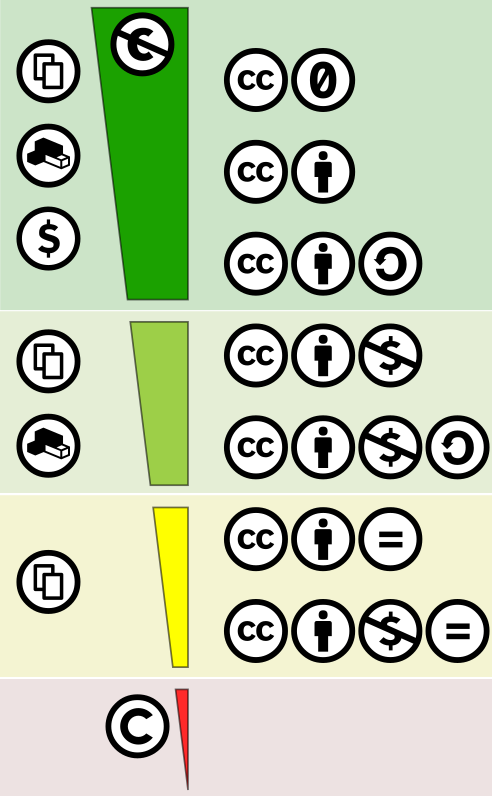Open Science for Arts, Design and Music/Guidelines/Open Research Work Cycle/Share
SHARE: make research data open while enabling reuse[edit]
This section answers the questions:
- How do Creative Commons licences work? How do I choose the right one for my research output?
- What are the different Open Access formats available?
- How can we check and guarantee the quality of Open Access content using a peer review process?
- How do I deal with issues of privacy and data anonymisation?
- How do I deal with ethical issues?
- How can I ensure the findability of my data and Open Access content?
- What are the dos and don'ts when sharing data on social media?
[edit]
CC licences
| ||||||||
|---|---|---|---|---|---|---|---|---|
Creative Commons Licenses[edit]Creative Commons (CC) Licenses are probably the most known and most widely used copyright non-exclusive licenses. CC Licenses promote the sharing and re-use of creativity and knowledge by replacing the default 'all right reserved' approach of copyright, with the 'some rights' reserved approach. In other words, they enable right holders (licensors) to release some of the rights that are granted by copyright law. CC licenses grant others (licensees) permission to use, share and modify licensors' creative works, and clearly define the conditions for such re-use. CC licenses vs. Copyright[edit]CC Licenses do not substitute copyright laws but simply offer right holders the possibility to organize and manage rights within the framework of existing copyright legislation. CC licenses are built within copyright law. A such they can be applied only to copyrightable works by the right holder. CC licenses cannot be applied to works that are included in the worldwide public domain. They do not limit or suppress any of the rights that are granted under the exceptions and limitations to copyright. Other types of intellectual property (e.g., patents and trademarks) are not covered by CC licenses. Creators retain the copyright and their right to be credited, while permitting reusers to copy and distribute their work. They work internationally and have they same lifespan as copyright. CC licenses[edit]CC licenses provide a range of options for creators who want to share their works with the public rather than reserving all rights under copyright.
There are six CC licenses that are a combination of one or more of the following four elements: The main decisions that a licensor must take when choosing one of the six CC licenses are:
Depending of the answers, the licensor can choose among six different license options, from least to most restrictive: CC licenses and the Public Domain[edit]In addition to the CC license suite, CC also has two public domain tools. Public domain tools and licenses are not equivalent. Open vs Not-Open CC Licenses[edit]According to the Berlin Declaration on Open Access to Knowledge in the Sciences and Humanities, all users should have a free, irrevocable, worldwide right of access and permission to copy, use, distribute, (...), make and distribute derivative works in any digital medium, for any responsible purpose, subject to proper attribution of authorship. Therefore, only three CC licenses are completely in line with such definition of “open”: CC0, CC-BY and CC-BY-SA. The other four CC licenses - CC BY-ND, CC BY-NC, CC BY-NC-ND and CC BY-NC-SA - are not considered “open” for they are more restrictive than the "open" requirements. |
Licence your work
| ||||||||||||||||||||||||||||||||||||||||||||||||||||||||||||||||||||||||||||
|---|---|---|---|---|---|---|---|---|---|---|---|---|---|---|---|---|---|---|---|---|---|---|---|---|---|---|---|---|---|---|---|---|---|---|---|---|---|---|---|---|---|---|---|---|---|---|---|---|---|---|---|---|---|---|---|---|---|---|---|---|---|---|---|---|---|---|---|---|---|---|---|---|---|---|---|---|
License your work[edit]Before choosing a CC license check that you control copyright in the work to which you wish to apply the license.
In case the use of third-party material does not allow for open licensing of each part of your work, DARIAH-EU recommends to use the least restrictive license applicable to your content. You can exclude third-party material from the license provision of your publication, but make sure to mark these exceptions clearly. This way the rights of the original copyright holder are respected while you are free to release your own publication under an open license. Adding a CC license to your work is simple. You just need include, somewhere in your work, all the information that others will need to properly attribute your work. The information are:
If you are publishing your content on an online platform, use the built-in CC license tools to mark your work with a CC license. What if someone does something with your CC licensed work you disagree with?[edit]As long as users comply with the terms and conditions of the CC license, you cannot control how your material is used. But, you can always choose not to be associated with your material or to uses of it that you don't like. In other words, you can waive the attribution requirement, thus require that the licensee remove the attribution information and choose not to be identified as the author-licensor or the original work. | ||||||||||||||||||||||||||||||||||||||||||||||||||||||||||||||||||||||||||||

